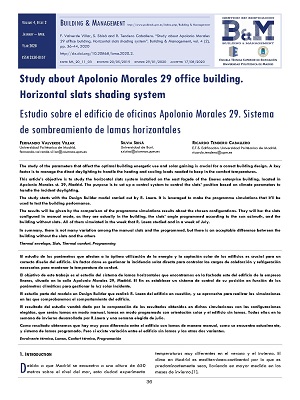
Study about Apolonio Morales 29 office building. Horizontal slats shading system = Estudio sobre el edificio de oficinas Apolonio Morales 29. Sistema de sombreamiento de lamas horizontales
DOI: https://doi.org/10.20868/bma.2020.2.4694
Texto completo:
PDFResumen
Abstract
The study of the parameters that affect the optimal building energetic use and solar gaining is crucial for a correct building design. A key factor is to manage the direct daylighting to handle the heating and cooling loads needed to keep in the comfort temperatures.
This article’s objective is to study the horizontal slats system installed on the east façade of the Eneres enterprise building, located in Apolonio Morales st. 29, Madrid. The purpose is to set up a control system to control the slats’ position based on climate parameters to handle the incident daylighting.
The study starts with the Design Builder model carried out by R. Laera. It is leveraged to make the programme simulations that it’ll be used to test the building performance.
The results will be given by the comparison of the programme simulations results about the chosen configurations. They will be: the slats configured in manual mode, as they are actually in the building, the slats’ angle programmed according to the sun azimuth, and the building without slats. All of them simulated in the week that R. Laera studied and in a week of July.
In summary, there is not many variation among the manual slats and the programmed, but there is an acceptable difference between the building without the slats and the others
Resumen
El estudio de los parámetros que afectan a la óptima utilización de la energía y la captación solar de los edificios es crucial para un correcto diseño del edificio. Un factor clave es gestionar la incidencia solar directa para controlar las cargas de calefacción y refrigeración necesarias para mantener la temperatura de confort.
El objetivo de este trabajo es el estudio del sistema de lamas horizontales que encontramos en la fachada este del edificio de la empresa Eneres, situado en la calle Apolonio Morales 29, Madrid. El fin es establecer un sistema de control de su posición en función de los parámetros climáticos para gestionar la luz solar incidente.
El estudio parte del modelo en Design Builder que realizó R. Laera del edificio en cuestión, y se aprovecha para realizar las simulaciones en las que comprobaremos el comportamiento del edificio.
El resultado del estudio vendrá dado por la comparación de los resultados obtenidos en dichas simulaciones con las configuraciones elegidas, que serán: lamas en modo manual, lamas en modo programado con orientación solar y el edificio sin lamas. Todas ellas en la semana de invierno desarrollada por R.Laera y una semana elegida de julio.
Como resultado obtenemos que hay muy poca diferencia entre el edificio con lamas de manera manual, como se encuentra actualmente, y sistema de lamas programado. Pero sí existe variación entre el edificio sin lamas y las otras dos variantes.
Palabras clave
Referencias
Ministerio de Fomento, CTE, “Código Técnico de la Edificación de España”, Governo de España, 2015;
Ministerio de Fomento, DB-HE, “Documento Básico de Ahorro de Energía”, Governo de España, 2016;
G. Kim, H. Soo Lim, T. Sub Li, L. Schaefer, J. Tai Kim, “Comparative advantage of an exterior shading device in thermal performance for residential buildings”, Energy and Buildings 46, 2012, p.p. 105-111;
K. Sun Lee, K. Jun Han, J. Wook Lee, “The Impact of Shading Type and AzimuthOrientation on the Daylighting in a Classroom–Focusing on Effec-tiveness of Façade Shading,Comparing the Results of DA and UDI”, Aca-demic editors: H. Yang, J. Peng, D. Karamanis, revistas: Energy, 2017;
A. Andriamamonjy; D. Saelens; R. Klein; “Automated IFC-based workflow for building energy performancesimulation with Modelica”, Automation in Construction 91, p.p. 166-181, 2018;
G. Vox; I. Blanco; E. Schettini; “Green façades to control Wall Surface temper-atura in buildings”, Building and Environment 129, p.p. 154-166, 2018;
G. Datta; “Effect of fixed horizontal louver shadingdevices on thermal perfomance of building byTRNSYS simulation”, Renewable Energy 23, p.p. 497-507, 2001;
R. Singh, R.L. Sawhney, I.J. Lazarus, V.V.N Kishore; “Recent advancements in earth air tunnel heat exchanger (EATHE) systemfor indoor thermal comfort application: A review”, Renewable and Sustainable Energy Reviews 82, p.p. 2162-2185, 2018;
3M, “Láminas 3M™ Control Solar”, empresa Innovadora, 2016;
https://www.madrid-tourist-guide.com/es/clima/clima-madrid.html;
https://energyplus.net/weather-location/europe_wmo_region_6/ESP//ESP_Madrid.082210_IWEC;
utilización del programa Climate 6.0
http://www.geshab.es/articulos-semana-mundial-edificacion sostenible-ejemplos.php;
Enlaces refback
- No hay ningún enlace refback.
Copyright (c) 2021 Autor / BY-NC-ND

Este obra está bajo una licencia de Creative Commons Reconocimiento-NoComercial-SinObraDerivada 4.0 Internacional.










